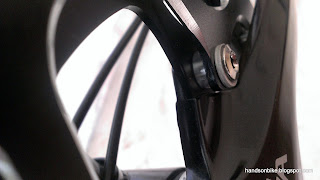The first SPD shoes that I had were the Shimano M230 MTB SPD shoes, which has a raised sole and metal studs at the front. They are also heavier and tougher. However, since I don't go off road, I don't actually need this kind of SPD shoes. A downside of that shoe is that the centre part of the bottom of the sole is actually hard plastic, which can be slippery when not clipped in.
Shimano M230 MTB SPD Shoes
I recently discovered that Shimano actually has a line of road touring SPD shoes. What is so special about these shoes is that they have a sleeker look, which makes it look more like a road shoe than a MTB shoe. Also, these shoes use SPD cleats instead of the road SPD-SL cleats, which makes walking much easier. They are also lighter and more comfortable than my current MTB SPD shoes as the sole is less thick and more flexible.
I was able to order these shoes online, as I know exactly what size I need. Usually when I buy shoes, such as running shoes or soccer shoes, I get US Size 9. For the MTB shoe, I was using EUR Size 42.5, which is equivalent to US Size 8.7. Even then, it felt slightly too big, as there is some movement even when all the straps are tightened. For the new RT82 shoes, I bought EUR Size 42, which is US Size 8.3. This makes it even smaller than my usual running shoes.
From what I read online, I see that very often, people recommend slightly larger sizes for cycling shoes, as they find that if they get the same size as their running shoes, the cycling shoes will be too tight. For example, someone who wears size 10 for their running shoe will get size 10.5 for their cycling shoe.
As for me, it works the other way round, as my cycling shoe size is smaller than my running shoe size. Seems that you cannot always generalise that your cycling shoe size should be smaller or larger than your running shoe size. What I suggest is that if you are buying cycling shoes for the first time, you must try it out at the shops! After that, if you are getting another pair, you may be able to estimate the size for the new pair of shoes. Of course, sizing and fit will differ from brand to brand, changing the brand of shoes will mean trying out the sizes at the shops again.
Here is a quick look at my new shoes!
Shimano RT82 Road Touring SPD Shoes
According to the marketing brochure, offset straps reduce pressure points on the foot
Ratchet locking system for the main strap
This size is perfect for my cycling shoes
Size view. Looks more like a road shoe.
Bottom view. Rubber sole all along the length, quite comfortable for walking.
New cleats for the shoe. Single release mode SH-51 SPD cleats.
Conservative design with touches of yellow at the tips of the shoe.
The shoe still feels a bit tough, as I have yet to break it in. The new cleats do feel more solid, with less play than the previous SH-56 SPD cleats that I was using. Will continue to try out these shoes and see how it fares.























